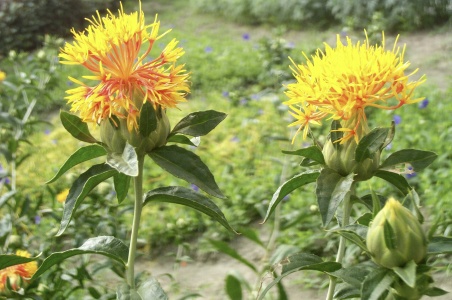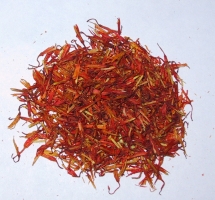Inner Path can not take any responsibility for any adverse effects from the use of plants. Always seek advice from a professional before using a plant medicinally.
Constituents.
 Research.
Research.The polysaccaride induces antibody formation in mice following peritoneal injection; these antibodyes cross react with antisera specific for Streptococcus pneumoniae type III and type VIII.[1]
Extracts have also been tested on blood coagulation, where a prolongation of clotting time was observed and platelet aggregation inhibited. Other properties include an increase in the tolerance of mice to hypoxia and a stimulant effect on the uterus, particularly the pregnant uterus, in animals. Clinically Safflower is used in China to treat coranary disease, thrombotic disorders and menstrual disturbances and alcholic extract are applied topically to ulcers and wounds.[2]
References
[1] Caldes, G. et al. (1981) J. Gen. Appl. Microbiol. 27, 157
[2] Pharmacology and Applications of Chinese Matria Medica Vol 1, Ed. H. Chan and P. But, Pub. World Scientific (1986) Singapore
Phytochemistry, pharmacology and medicinal properties of Carthamus tinctorius L.
Asgarpanah J, Kazemivash N.
Abstract
Carthamus tinctorius L. is commonly known as Safflower. C. tinctorius extracts and oil are important in drug development with numerous pharmacological activities in the world. This plant is cultivated mainly for its seed, which is used as edible oil. For a long time C. tinctorius has been used in traditional medicines as a purgative, analgesic, antipyretic and an antidote to poisoning. It is a useful plant in painful menstrual problems, post-partum hemorrhage and osteoporosis. C. tinctorius has recently been shown to have antioxidant, analgesic, anti-inflammatory and antidiabetic activities. Carthamin, safflower yellow are the main constituents in the flower of C. tinctorius. Carthamidin, isocarthamidin, hydroxysafflor yellow A, safflor yellow A, safflamin C and luteolin are the main constituents which are reported from this plant. Caryophyllene, p-allyltoluene, 1-acetoxytetralin and heneicosane were identified as the major components for C. tinctorius flowers essential oil. Due to the easy collection of the plant and being widespread and also remarkable biological activities, this plant has become both food and medicine in many parts of the world. This review presents comprehensive analyzed information on the botanical, chemical and pharmacological aspects of C. tinctorius.
PMID: 23371463 DOI: 10.1007/s11655-013-1354-5 |Chin J Integr Med. 2013 Feb;19(2):153-9. doi: 10.1007/s11655-013-1354-5. Epub 2013 Jan 31. ncbi.nlm.nih.gov
Antioxidative compounds isolated from safflower (Carthamus tinctorius L.) oil cake.
Zhang HL, Nagatsu A, Watanabe T, Sakakibara J, Okuyama H.
Abstract
Seven antioxidative serotonin derivatives were isolated from safflower (Carthamus tinctorius L.) oil cake. Their structures were established as N-[2-(5-hydroxy-1H-indol-3-yl)ethyl]ferulamide (1), N-[2-(5-hydroxy-1H-indol-3-yl)ethyl]-p-coumaramide (2), N,N'-[2,2'-(5,5'-dihydroxy-4,4'-bi-1H-indol-3,3'-yl)diethyl]- di-p-coumaramide (3), N-[2-[3'-[2-(p-coumaramido)ethyl]-5,5'-dihydroxy- 4,4'-bi-1H-indol-3-yl]ethyl]ferulamide (4), and N,N'-[2,2'-(5,5'-dihydroxy-4,4'-bi-1H-indol-3,3'-yl)diethyl]- diferulamide (5), N-[2-[5-(beta-D-glucosyloxy)-1H-indol-3-yl)ethyl]- p-coumaramide (6), and N-[2-[5-(beta-D-glucosyloxy)-1H-indol-3-yl)ethyl]ferulamide (7). Antioxidative activities of the compounds were measured by the ferric thiocyanate method and the alpha,alpha-diphenyl-beta-picrylhydrazyl (DPPH) method, and compounds 1-5 were found to have relatively strong antioxidative activity.
PMID: 9433760 Chem Pharm Bull (Tokyo). 1997 Dec;45(12):1910-4. ncbi.nlm.nih.gov
Hair growth-promoting effect of Carthamus tinctorius floret extract.
Junlatat J, Sripanidkulchai B.
Abstract
The florets of Carthamus tinctorius L. have traditionally been used for hair growth promotion. This study aimed to examine the potential of hydroxysafflor yellow A-rich C. tinctorius extract (CTE) on hair growth both in vitro and in vivo. The effect of CTE on cell proliferation and hair growth-associated gene expression in dermal papilla cells and keratinocytes (HaCaT) was determined. In addition, hair follicles from mouse neonates were isolated and cultured in media supplemented with CTE. Moreover, CTE was applied topically on the hair-shaved skin of female C57BL/6 mice, and the histological profile of the skin was investigated. C. tinctorius floret ethanolic extract promoted the proliferation of both dermal papilla cells and HaCaT and significantly stimulated hair growth-promoting genes, including vascular endothelial growth factor and keratinocyte growth factor. In contrast, CTE suppressed the expression of transforming growth factor-β1 that is the hair loss-related gene. Furthermore, CTE treatment resulted in a significant increase in the length of cultured hair follicles and stimulated the growth of hair with local effects in mice. The results provided the preclinical data to support the potential use of CTE as a hair growth-promoting agent.
PMID: 24338940 DOI: 10.1002/ptr.5100 Phytother Res. 2014 Jul;28(7):1030-6. doi: 10.1002/ptr.5100. Epub 2013 Dec 11. ncbi.nlm.nih.gov
Potent α-glucosidase inhibitors from safflower (Carthamus tinctorius L.) seed.
Takahashi T, Miyazawa M.
Abstract
As part of the search for naturally derived α-glucosidase inhibitors, the chemical components isolated from safflower seed (Carthamus tinctorius L.) were evaluated. The compounds active as α-glucosidase inhibitors were serotonin derivatives (e.g. N-p-coumaroyl serotonin (1) and N-feruloyl serotonin (2)). These compounds showed a potent inhibitory activity, the 50% inhibitory concentration (IC(50) ) values were calculated as 47.2 µm (1) and 99.8 µm (2) while that of the reference drugs acarbose and 1-deoxynojirimycin were evaluated as 907.5 µm and 278.0 µm, respectively. Regarding the structure of the serotonin derivative, the existence of the hydroxyl group at 5-position in the serotonin moiety and the linkage of cinnamic acid and serotonin are essential for α-glucosidase inhibitory activities. These results are helpful for the proper use of safflower seed as traditional medicine for the treatment of diabetes, moreover, it could serve to develop medicinal preparations as supplements and functional foods for diabetes. In particular, the serotonin compounds could be used as a lead compound for a new potential α-glucosidase inhibitor derived from the plant.
PMID: 22021176 DOI: 10.1002/ptr.3622 Phytother Res. 2012 May;26(5):722-6. doi: 10.1002/ptr.3622. Epub 2011 Oct 24. ncbi.nlm.nih.gov
 Carthamus
tinctorius. 红
花
Hóng huā
Safflower
Family: Asteracea
Carthamus
tinctorius. 红
花
Hóng huā
Safflower
Family: Asteracea
 FLAVOR: Acrid, Pungent.
CHANNEL: Heart, Liver
FLAVOR: Acrid, Pungent.
CHANNEL: Heart, Liver 